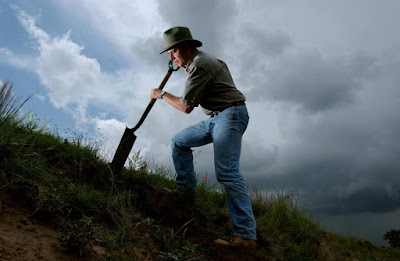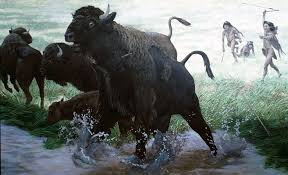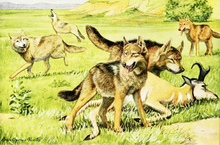The photos, taken by Ranger Joy Guffy, show the coyote attempt to chase the tiny calf and grab it, while the mother bison fights back.
CALF FROM THE COYOTE
Yellowstone National Park shared the photos on Twitter Tuesday and called the coyote "determined."
According to Yellowstone National Park, the bison had recently given birth.
While there aren't numbers on the bison calfs killed by coyotes or wolves each year, it's not uncommon for the young to become targets, according Jonathan Shafer, a Yellowstone National Park spokesman.
"When it comes to smaller animals, they're definitely preferred prey," Shafer told USA TODAY in a phone interview. "It's easiest to catch something small."
After giving birth, a cow bison successfully defended her newborn calf from a very determined coyote. (Courtesy Ranger Joy Guffy)
------------------------------------
Threat of predation: do ungulates behave aggressively towards different members of a coyote pack?
ABSTRACT
Wild ungulates have evolved a variety of antipredator strategies to deter or escape predation by carnivores. Among wild canids, the dominant pair of a pack often initiates attacks upon prey. Previous observations in Yellowstone National Park, Wyoming, showed that the alpha pair in a coyote (Canis latrans) pack most often leads attacks on ungulates during winter.
We were interested in determining whether ungulates can distinguish (perhaps by body size or posture) which members of a coyote pack are the alpha individuals, and whether they initiate and direct aggressive behavior towards those members of the pack that pose the greatest threat of predation to themselves and (or) their offspring. During 2507 h of behavioral observations on 54 coyotes between January 1991 and June 1993, we observed 51 interactions between coyotes and adult elk (Cervus elaphus), bison (Bison bison), and pronghorn antelope (Antilocapra americana) in Yellowstone National Park.
Adult Bison starting down two Coyotes
Adult Bison starting down two Coyotes
The interactions analyzed here are those in which the ungulate appeared to initiate aggressive behavior towards the coyote(s) and were not a response to an attack by the predators. We found that aggression by ungulates towards coyotes was highest during the summer months, when calves and fawns were present; female ungulates were more frequently aggressive than males.
The frequency of aggression of adult ungulates towards small and large groups of coyotes was equal to the frequency of occurrence of these groups. Ungulates directed aggressive behavior more frequently towards alpha coyotes and were less aggressive towards beta coyotes and pups. Large ungulates, particularly elk and bison, appeared to perceive that alpha coyotes posed a greater threat to themselves and their offspring. The smaller ungulate, the pronghorn antelope, directed aggressive behavior equally towards all coyotes. Adult ungulates were probably responding to the larger body size of the alpha coyotes and the tendency of alpha coyotes to travel at the front of the pack.


























